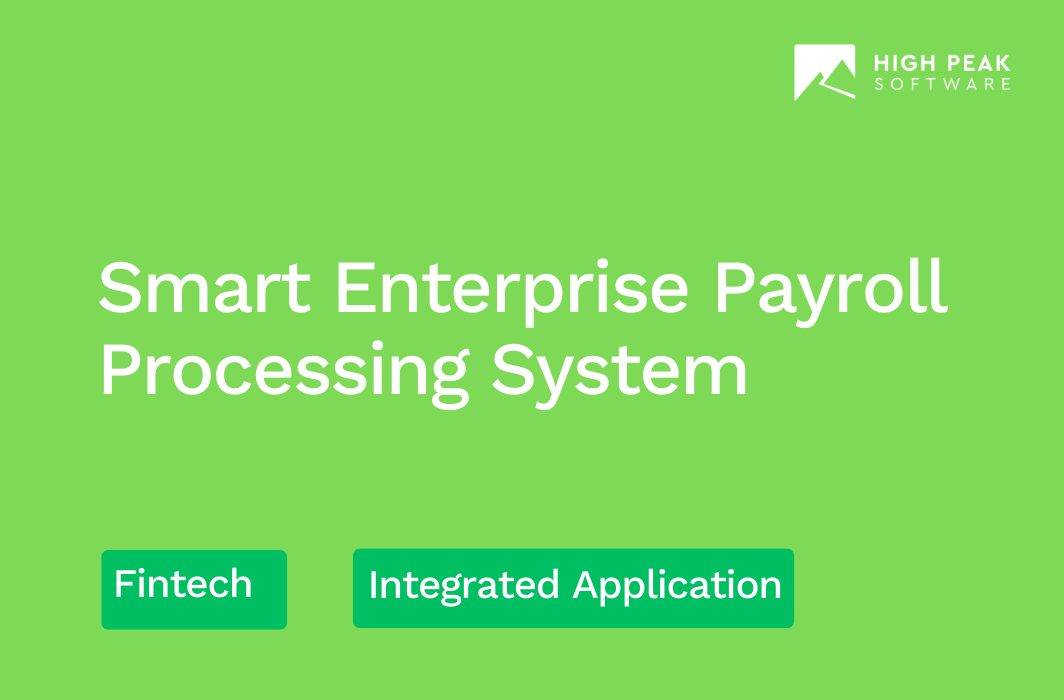Automated Payment Processing Solutions

Table of Contents
- Why did our client approach High Peak?
- High Peak’s development team faced several technical and methodical challenges while automating our client’s payment environment
- Creating an environment that automates and synchronizes disparate functions of the payments operation system.
- Streamline your internal operations by building an impactful product with High Peak Software
High Peak simplifies/streamlines the client’s payment processing environment with automated payment reminders and credit scoring solutions
About the client
Our client is a financial technology solutions provider for several industries—with a main focus on Fleet, Corporate payments, and Benefits. Simply put, they lend money to big companies, acting as an intermediary between the debtor and the client. They offer several other Payment Processing Solutions aimed at simplifying complex financial processes and enabling their partners and customers make data-driven business decisions.
They take on the operationally heavy task of handling the client and debtor accounts, extracting and processing all transactional data and establishing a systematic possess to fast track the repayment process.
As a company, they offer a multitude of financial services for several industries—but in order to streamline their internal product operations, they reached out to High Peak. The project’s goal was to incorporate a DevOps approach to their service delivery—to enable improved service and application delivery.
Why did our client approach High Peak?
As a company that aims to provide simplified solutions for complex payment processes, our client was manually processing about 8,000 to 20,000 invoices every single day, consuming upto 9 dedicated hours per day.
The manual execution of this process was complicated and incessant. The existing master data would consist of current accounts, new accounts and a recurring carry forwards of pending accounts. This means that a particular debtor will transition from one category of the master data to another, making it no less than 180,000 rows of data to be managed daily.
The process was not only error-prone—but it also consumed too much time, manual effort, and additional resources. Over time, it increased the company’s overhead costs for an avoidable task.
All communications among our client, their clients and the debtors were off-platform and disorganized. Moreover, they had to be manually processed, including the attachments consisting of invoices, checks, and other payment documents.
Our client wanted to streamline payment processing solutions between the client and vendor payment operations (invoicing and payment processing) through the development of an end-to-end ecosystem that would facilitate:
- Email engagement: Our client wanted to automate payment reminders which were previously done manually through email engagement campaigns based on certain business rules.
- Automated Clearing House (ACH): Clients and debtors usually send emails with ACH payment information in the body of the email and as attachments. Our client wanted to automate the extraction of relevant information from both structured and unstructured data.
- Remittance: They wanted to ensure secure and automatic extraction of payment information from the checks and invoices that were being manually extracted and validated.
- Credit scoring: They wanted to make use of predictive scoring models to assess the eligibility of potential new engagements with clients and debtors based on their financial history.
High Peak’s development team faced several technical and methodical challenges while automating our client’s payment environment
High volumes of manual invoice data management
Our client was processing more than 180,000 emails every single day. This entire process was being carried out manually and required a substantial amount of time and effort. In addition, the amount of resources and manual labor costs involved in the process posed a major challenge for the organization.
They had to systematically manage 180,000 rows of data every single day. This included assessing their repayment status updates, categorizing them into groups and subgroups based on their status and much more.
On top of this extremely strenuous and redundant data management process, they also had to manually extract a large amount of invoice and payment data after filtering every single email body copy and their attachments. The collected data then had to be validated against the previously assembled master spreadsheet.
This was a highly time consuming and error-prone process. As invoice data management is a crucial process in payment processing solutions, it needs a more streamlined and intelligent approach.
Disintegrated and disorganized email communications/ payment reminder systems between our client, their clients and debtors
Before establishing a strategic and automated system for the payment reminder, our client employed a manual off-platform process to coordinate with clients and debtors.
Due to the sheer volume of emails they were dealing with, it was practically impossible to keep track of all of them between the consistent flow of emails containing similar contents.
In the initial stages of building a systematic process, the High Peak team faced several hurdles including:
- The system shutting down frequently and disrupting the flow of emails.
- Having to come up with a workflow that can process 5000 to 8000 invoices including those that were pending.
- Determining the suitable email drip flow and the right time and intervals between an email and its follow-ups.
Extracting accurate data from structured and unstructured data across thousands of email chains
Email attachments from debtors and clients carry significant invoice and payment data that must be extracted for information management and client scoring.
Earlier, the data was extracted through Tesseract OCR engine (Optical Character Recognition), but the results were substandard and the accuracy rate was not upto the mark.
Hence, High Peak optimized the OCR pipeline to improve accuracy, speed, and the processing power. The team then employed Google Vision OCR for optimum accuracy and speed.
In order to speed up the performance further and handle a large amount of inbound email traffic, HPS employed multithreading for handling several documents at once.
Without any email parsing solutions in place the manual data extraction required a copious amount of work.
The email body copy was manually studied to extract the relevant payment information.
This was followed by extracting relevant data from the email attachments using specific keywords input in the OCR engine. The data could be in the form of free-form or smudged text from handwritten documents like checks or invoices. In some cases, the company also received screenshots or blurry images of such documents—making it harder to extract information.
Developing a precise credit scoring systems for potential clients & debtors based on established parameters
Our client is a lender—which means that any time they’re lending money to a debtor or client, they have to make sure that these companies have the capability to pay them back. Establishing proper payment Processing solutions like credit scoring system to score the clients and the debtors based on their financial history was crucial.
It allows them to filter and qualify potentially fruitful clients and categorize existing debtors based on their credit. This scoring model eventually became the foundation of their payment reminder campaign flow.
However, establishing an accurate scoring model that can interpret the client’s and debtor’s credit behavior and segregate them was challenging. We had to understand the basis of how clients and debtors are scored—and then build deep learning (DL) algorithms to accurately predict it.
Creating an environment that automates and synchronizes disparate functions of the payments operation system.
Building an automated email engagement model for payment reminders and data collection for decision making
High Peak designed an Email Engagement Model that facilitates seamless and two-way communication between our client and their debtors.
The Email Engagement model uses preset templates that are sent based on where a debtor stands in the repayment pipeline.
This Email Engagement Model strategizes all communications based on the judgment of the debtor scoring model that partially determines the urgency and flow of repayment reminders.
High Peak also designed the entire email flow with special attention to the user interface and interactivity of the templates, whereby the recipients can respond to the reminders within seconds with just a click.
For instance, when a debtor is due for repayment, the system will push the first email reminder that confirms whether the recipient has all the documents needed.
The respondent (debtor) can respond by clicking on the yes or no button that will automatically navigate them to the follow-up question that allows our client to collect more accurate and specific data.
Each of the templates are designed to suit the circumstance, track the debtor’s repayment status and inconveniences and allow them to respond instantaneously and easily. The accuracy rate for this module was between 70% to 80% and it was checked multiple times in a day.
Building an automated inbound payment system to autonomously extract relevant payment information from email attachments
The email communication with debtors is automatically parsed to extract data from the email body copy and attachments. This data usually includes payment and invoice information.
Manually extracting data from these attachments can be a tiresome task as the attachments can be fuzzy, hand written, screenshots and snapshots of documents. On top of that, they arrive in pretty much every fathomable form including digital attachments (CSV files, PDFs) and scanned copy attachments (images files such as TIFF, PNG).
High Peak built the Automated Clearing House (ACH) network for our client which extracts usable information from these structured and unstructured data. Using that data, it generates a report and pushes that data forward to our client on a regular basis.
The role of this payment processing solutions application is to autonomously and securely detect whether an email has an attachment of either an invoice or a payment check and accurately extract relevant payment information.
The ACH module did not make use of any advanced technologies. Instead, the template was hard coded—meaning that the parser is trained to read the email template based on a specific format. Anything other than that would result in an error message. In this case the accuracy rate was above 70% which was optimal as per the client’s requirements. The accuracy check was conducted once a day at a designated time.
Automating this process offloaded the employees from the redundant, error-prone and utterly dull task of dissecting every email and their respective attachment files to gather all useful data from the emails.
Enabling check processing, digitizing, handwritten info extraction, and reporting
Another key challenge was to extract information from physical documents like checks that were handwritten, invoices, and more. Given the number of incoming emails in a day, our client had to employ over a team of 40 to digitize and code these documents accurately in their systems.
It resulted in an unnecessary tedious and time consuming process—along with a glaring waste of resources. So, High Peak built a system that extracted information from these remittances. Initially when we employed Tesseract OCR, we did not see a high accuracy rate. While we were building our own internal OCR system, our team realized that we could leverage Google Vision’s OCR system for this purpose.
Ensuring a high accuracy rate was particularly challenging because we had to make a number of assumptions to extract the data from the checks. The system then validates the extracted data against the templates.
This system however came with inherent challenges that called for some human intervention every now and then. For example, since the data extraction is largely based on certain assumptions, the system cannot accurately extract data if the template is inconsistent.
For instance, if the system is coded to assume that ‘the account number is followed by the amount digits’, the system will almost always assume that order to interpret the data.
If this template is disturbed, it may generate inaccurate results. This was resolved with manual monitoring to balance out the disturbances within the parsing logic and mitigate it to produce accurate and verified results.
When we did so, we were able to extract information from handwritten copies, and other documents. Not just that, we were able to digitize these documents accurately too. Basically, we provided the parsing technology, and our client’s team verified and validated the data. The output is generated in an Excel or CSV format—accessible to the client’s team.
Over time, an activity that used to take over 40 people three to five hours a day could now be done by a team of 10 in a couple of hours. The accuracy checks were done using Robotic Processing Automation (RPA) algorithms.
Replacing manual credit scoring with DL-based automated models that assign credit scores based on specific parameters
To ensure that our client was engaging with clients and potential debtors who had the capability to pay them back, we built a credit scoring model too. High Peak developed separate DL-based models to automate the debtor and client scoring process based on distinguished parameters.
The model catering to the debtor scoring process evaluates current debtors on the basis of factors like:
- When the payment was made
- How much of the amount was repaid
- Current month and previous month’s Ansonia score (credit report)
- Cross-aging metrics (previous & present month’s overdue amount)
The debtors are then graded individually against each of these parameters as per the preset model. For instance, to score a debtor against their time (promptness) of payment, the debtors are grouped into the following brackets: Paid within 30-45 days, 45-60 days, 60-90 days or more than 90 days.
Similarly, the model catering to the potential client scoring process evaluates the clients based a range of technical parameters like:
- Days Turn
- Dilution
- Gross Dilution
- Collection Ratio
- Advance Rate
- Delinquency Ratio
Based on this information, the algorithm decides whether or not the debtor and client will actually be able to pay our client the loaned amount. This allows our client to streamline their payment operations and make calculated and informed business decisions.
Streamline your internal operations by building an impactful product with High Peak Software
Our client was able to smoothen their internal payment processing operations using the four modules we designed for them. Right from extracting data from their email chains, to automating credit scoring of the clients—these modules were able to do it all.
It helped in reducing their overhead costs and increasing the efficiency of their end-service delivery. If you’re looking for a product development partner to do the same for you, look no further. Reach out to High Peak today—and let’s build together!




